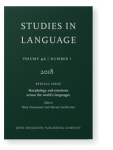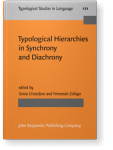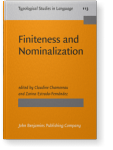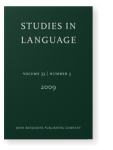Françoise Rose
List of John Benjamins publications for which Françoise Rose plays a role.
2025 Is there a typological profile of isolates? Investigating Language Isolates: Typological and diachronic perspectives, Salaberri, Iker, Dorota Krajewska, Ekaitz Santazilia and Eneko Zuloaga (eds.), pp. 22–47 | Chapter
Across the linguistic literature, one occasionally encounters claims of typological differences between isolates and non-isolates, but these are often vague, and tend to use isolates as proxies for small community size, hunter-gatherer societies, and/or socially/geographically isolated languages. read more
2018 Chapter 2. Nonverbal predication and the nonverbal clause type of Mojeño Trinitario Nonverbal Predication in Amazonian Languages, Overall, Simon E., Rosa Vallejos and Spike Gildea (eds.), pp. 53–84 | Chapter
Mojeño Trinitario, an Arawak language spoken in Bolivia, makes frequent use of clauses without a verb or a copula. These encode some of the most common semantic types of nonverbal predication – equation, inclusion, attribution (as understood by Payne 1997), but also typologically neglected types,… read more
2018 The rise and fall of Mojeño diminutives through the centuries Morphology and emotions across the world's languages, Ponsonnet, Maïa and Marine Vuillermet (eds.), pp. 146–181 | Article
This paper investigates the diachrony of diminutives in Mojeño across four centuries. First, it shows that the three Mojeño diminutives have two lexical sources: ‘child’ and ‘seed’. This constitutes a counterexample to Jurafsky’s (1996) theory concerning the universal source of diminutives.… read more
2018 Chapter 8. Are the Tupi-Guarani hierarchical indexing systems really motivated by the person hierarchy? Typological Hierarchies in Synchrony and Diachrony, Cristofaro, Sonia and Fernando Zúñiga (eds.), pp. 289–308 | Chapter
Tupi-Guarani languages are supposedly perfect examples of hierarchical indexing systems, where the relative ranking of A and P on the 1 > 2 > 3 person hierarchy determines the selection of the person markers. This chapter questions the relevance of the person hierarchy as a synchronic and… read more
2016 On finitization Finiteness and Nominalization, Chamoreau, Claudine and Zarina Estrada-Fernández (eds.), pp. 345–370 | Article
Most diachronic studies dealing with finiteness are centered on the functional shift between main and dependent clause status. In contrast, this paper focuses on the acquisition of morphosyntactic finiteness features by a non-finite dependent construction that remains dependent, namely… read more
2013 Finitization: A shift of dependency-coding strategy from Proto-Tupi-Guarani to Emérillon Diachronica 30:1, pp. 27–60 | Article
This paper offers a detailed account of a change from non-finite to finite dependent clauses in Emérillon, a Tupi-Guarani language spoken in French Guiana, and presents it as the syntactic context within which loss of ergativity occurred. It shows that the previously described change of the… read more
2009 The origin of serialization: The case of Emerillon Studies in Language 33:3, pp. 644–684 | Article
This paper gives clear synchronic evidence for the origin of serial verb constructions (SVCs) in Emerillon, a Tupi-Guarani language. SVCs in that language result from a gerundive construction after the loss of both a subordinator and an indexation pattern specific to dependent clauses. After a… read more






